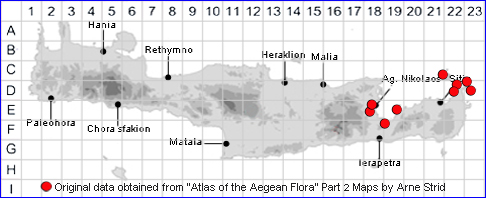

SPECIES DESCRIPTION
LIMONIUM SITIACUM
Including
Family and Genus:- See- PLUMBAGINACEAE
Common Names:- None
Homotypic Synonyms:- None
Meaning:- Limonium (Gr) Meadow-plant. A name used by the Greek physician
and botanist Dioscorides.
Sitiacum (L) From the area of Sitia, east Crete.
General description:- Glabrous perennial with a laxly branched woody stock,
forming loose tufts.
Stems:-
1) 10-30 cm. slender, sparingly branched, papillose and rough, sterile branches
lacking or few.
Leaves:-
1) Basal, several, suberect, in a loose rosette, spathulate and 5-8 mm wide near
the apex, sometimes folded or canaliculate, tapering to a long petiole, rounded
to truncate or mucronate at the apex, coriaceous, glaucous, densely covered
with crateriform glands.
Flowers:-
1) Spikes, long and lax, with slender, 1-3-flowered spikelets 8.5-10 mm.
2) Calyx, 6-7 mm, narrowly tubular, subglabrous.
3) Corolla, c. 9 mm, lilac
Habitat:- Halophytic communities on rocky and sandy coasts, also in dry open
shrubby vegetation on dry, rocky slopes, mainly of hard limestone, up to 200 m.
Distribution:- Endemic, restricted to hot and dry habitats in the SE Aegean area.
On Crete restricted to the east.
Flowering time:- May-June.
Photos by:- Christopher Cheiladakis


~~~~~~~~~~~~~~~~~~~~~~~~~~~~~~~~~~~~~~~~~~~~~~~~~~~~
LIMONIUM OLIGOTRICHUM Back to Top
Homotypic Synonyms:- None
Meaning:- Oligotrichum (L) Refers to the presence of just a few hairs on the
upper part of the inner bract.
Resembling Limonium sitiacum, but differering in the following characters
1) Narrower leaves.
2) Having more remotely arranged spikelets.
3) Somewhat shorter and hairy inner bracts.
Habitat:- Coastal limestone cliffs, occasionally in dry open shrubby vegetation on
rocky slopes up to 100 m
Distribution:- Endemic to the Aegean area and known only from a few collections;
Very rare on Crete, currently known from only one location in the far east.
Flowering time:- June-July.
Photos:- Currently unavailable
~~~~~~~~~~~~~~~~~~~~~~~~~~~~~~~~~~~~~~~~~~~~~~~~~~~~
LIMONIUM CALLIOPSIUM Back to Top
Homotypic Synonyms:- None
Calliopsium Meaning unknown.
Resembling Limonium sitiacum, but differering in the following characters
1) Somewhat larger in all parts.
2) Stem smooth.
3) corolla sky-blue.
Habitat:- Rugged limestone coast, in strongly saline habitats close to the
waterline.
Distribution:- Cretan endemic. Known only from the Northwest coast of Crete.
Very rare.
Flowering time:- June-Aug.
Photos by:- Fotis Samaritakis
